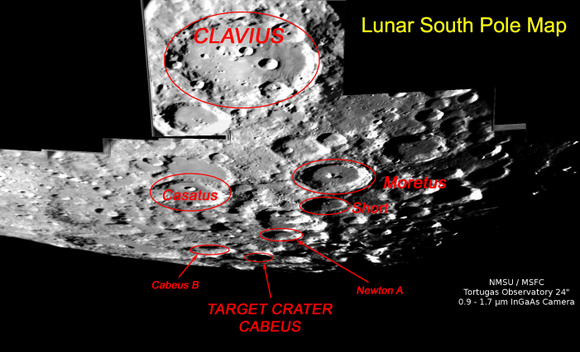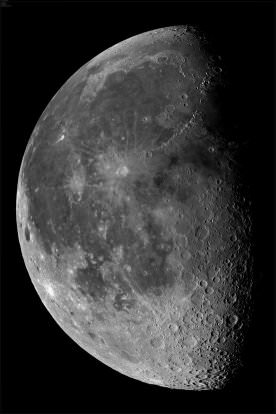[/caption]
The LCROSS spacecraft is going to impact the Moon on Friday, October 9, and here’s your chance to watch the action, either just for fun, or to contribute to scientific observations. Whether you want to observe with your own equipment or watch the event on television or a webcast, below you’ll find all the information and links you should need to be a part of history. Amateur astronomers need a 10-inch or bigger telescope to make observations.
When: Following the latest trajectory correction maneuvers, the time of impact on Friday, October 9, 2009 is 11:31:19 UTC for the Centaur and 11:35:45 for LCROSS spacecraft (7:31:19 a.m. EDT and 7:35:45 a.m. EDT).
The impact time may be refined as the time for impact comes closer. You can check the LCROSS mission Facebook and Twitter pages for the latest updates (and we’ll try to post it here as soon as possible after any changes are announced.) Also check this NASA website for more information.
Where: both spacecraft are targeting Cabeus crater. The impact site coordinates are -84.675, 311.275 E. Click here to download the Targeting Coordinates, Timing, and Finder Charts presentation for detailed information. (Powerpoint presentation.)
New Mexico State University and Marshal Space Flight Center have made finder charts available based on similar illumination and libration that we expect to see on the night of the impact.
In general, here’s where to look: Start with the south pole (bottom edge) and look for the terminator, or where the sunlight and shadow merge. Here’s what the Moon should look like:
Zoom in with your telescope and identify the Cabeus craters. The target is in Cabeus proper, near the bottom of the Moon. Here’s what it should look like, along with a notated image:
What will I see? Based on an projections, there should be a visible ejecta cloud rising to 6Km above the lunar surface and crater wall. Latest estimates of the Cabeus proper crater impact site indicate the first two or three kilometers of that plume height (the brightest parts) may not be viewable from Earth, but that the plume will hopefully have crater wall shadow behind it to help us see it. Impact design location is to maximize the amount of this in sunlight, but variables here will determine how much of it is actually illuminated, and it may be that only the high power instruments will see good contrast. But we don’t know for sure.
“We expect the debris plumes to be visible through mid-sized backyard telescopes—10 inches and larger,” says Brian Day of NASA/Ames. Day is an amateur astronomer and the Education and Public Outreach Lead for LCROSS. “The initial explosions will probably be hidden behind crater walls, but the plumes will rise high enough above the crater’s rim to be seen from Earth.”
See this page for more information.
What is actually going on? The 5,000-pound (2,270-kilogram) Centaur is expected to slam into Cabeus at a sharp angle at a speed of 5,600 mph (9,000 kilometers per hour). If all goes according to schedule, the shepherding vehicle, carrying nine science payloads, will follow the Centaur’s plunge into the moon, and send back data live to Earth. The Centaur’s collision is expected to create a crater roughly 60 or 70 feet wide (20 meters wide) and perhaps as much as 16 feet (5 meters) deep, ejecting approximately 385 tons of lunar dust and soil — and hopefully some ice. In addition to recording the collision, the shepherding spacecraft weighing, 1,500-pounds (700-kilograms) will fly through the regolith plume thrown up by the collision, just before it too slams into the lunar surface some four minutes later, kicking up its own smaller plume of debris, all the while using its sensors to look for telltale signs of water.
What if it is cloudy where I live, or I live in Europe/Asia and it is daytime, or I don’t have a telescope to watch?
You can watch the event on NASA TV, and here’s where you can watch it online.
Slooh is having a webcast and will have two telescopes trained on the impact site.
The Exploratorium is also showing a webcast.
If you want to watch with other space enthusiasts, check out this list of people and organizations that are sponsoring observing parties.
Also, if you are in Mumbai, India the Nehru Planetarium there has a free viewing of the event at 4 pm IST. (thanks for pradx on Twitter for that info.)
If you are in the Pasadena area, JPL’s Von Karman Auditorium will have a public viewing, opening the gates 3:00 am. local time.



Very cool. I wonder why they will continue this mission when India has discovered water on the moon? Is there really a chance for liquid water?
Supposed to be cloudy and rainy here so I’ll be watching it online. Sure hope no aliens are on vacation in that area of the moon Friday 😉
@Brink
If LCROSS finds what we hope it does, it will mean vast amounts of water ice under the surface of the moon, in the quantities with which can be easily mined for resources during colonization. The discovery of trace amounts of water in the lunar soil that was made by India as well as other countries is very exciting, but still equals only a few ounces of water per ton of soil.
Hopefully this doesn’t breach comment regulations but I found this blog with a slightly amusing stint on the moon impact:
http://www.bandofslugs.co.uk/4261/honest-news/nasa-solves-problem-of-coastal-erosion.html